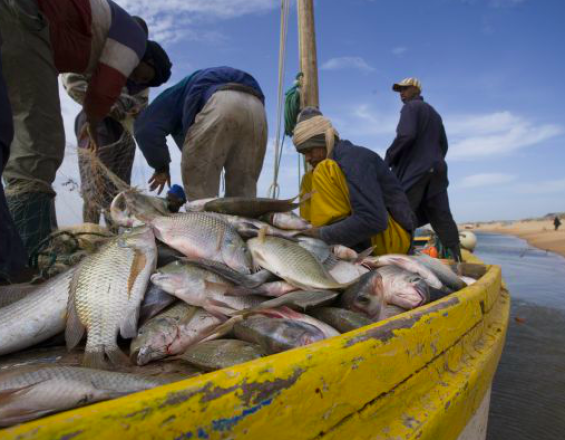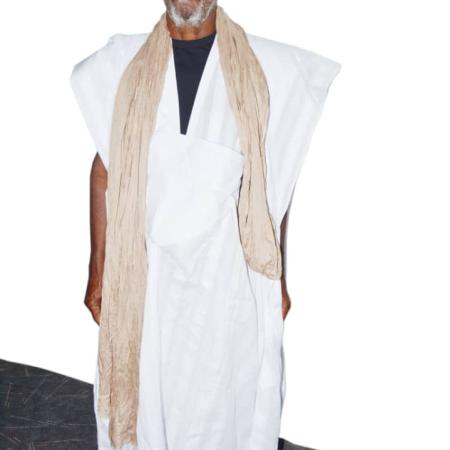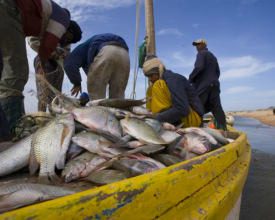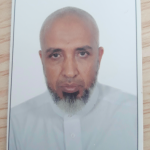
Vigilancia marítima participativa en el Parque Nacional del Banc d'Arguin

Con una superficie de 12.000 km2. - de los cuales 6.300 son zonas marinas y 5.700 están en el continente- el Parque Nacional del Banc d'Arguin (PNBA) es uno de los mayores parques nacionales de África. Es lugar de cría del zarapito real, de maduración del mújol amarillo y alberga numerosas aves migratorias y especies de peces. El parque también alberga extensas praderas intermareales y submareales de algas marinas. Otra característica excepcional del PNBA es la presencia de los imraguen, una población de pescadores del desierto. Tienen derechos ancestrales y exclusivos sobre los recursos pesqueros como parte de sus prácticas tradicionales, utilizando embarcaciones de vela latina llamadas "lanches". La importancia del PNBA en términos de biodiversidad y patrimonio cultural exige garantizar su integridad socioecológica. Conscientes de esta situación, los gestores del PNBA y la Delegación de Vigilancia y Control de la Pesca en el Mar (DSPCM) -actual Guardia Costera Mauritana (GCM)- pusieron en marcha en 1999 un sistema participativo de vigilancia marítima.
Contexto
Défis à relever
Hay que señalar varios retos en el contexto de la vigilancia marítima participativa establecida en el PNBA:
- La intensificación de la pesca artesanal motorizada en Mauritania a lo largo de los años (presión externa al parque).
- El aumento de las prácticas de pesca ilegal dentro del parque
- El desarrollo de infraestructuras de transformación y conservación de los productos de la pesca. A pesar de contribuir al desarrollo socioeconómico de la población, esto también aumenta el esfuerzo pesquero y, por tanto, la presión sobre los recursos pesqueros.
- Limitaciones de la capacidad de vigilancia debidas a la obsolescencia de los equipos y a la insuficiente autonomía de los buques.
- El coste económico del sistema, sobre todo en la vasta superficie de territorio marino y costero que hay que vigilar.
Ubicación
Procesar
Resumen del proceso
Los tres bloques se complementan entre sí. Los bloques 1 y 3, respectivamente "Gobernanza compartida" y "Actividades de sensibilización e intercambio de conocimientos", garantizan las condiciones intangibles necesarias para el éxito de esta solución. El bloque 2, "Apoyo a las actividades económicas y a los ingresos alternativos", se ocupa de las condiciones materiales. Idealmente, estos tres elementos deberían desarrollarse en paralelo. Sin embargo, también pueden aplicarse uno tras otro y de forma independiente.
Bloques de construcción
Gobernanza compartida
El sistema participativo de vigilancia marítima del PNBA es el resultado de una colaboración tripartita, que integra a la población residente de Imraguen, junto a los gestores del parque y los guardacostas (GCM). Este sistema tiene por objeto controlar la entrada de embarcaciones procedentes del exterior del PNBA, en particular de piraguas motorizadas, prohibidas en el interior del parque desde su creación en 1976.El respeto del calendario de las temporadas de pesca se considera hoy un modelo de éxito en la subregión de África Occidental. La experiencia del PNBA ha beneficiado a la Red Regional de Áreas Marinas Protegidas de África Occidental (RAMPAO), especialmente a través de misiones de apoyo técnico y visitas de intercambio. El funcionamiento del mecanismo de vigilancia participativa del PNBA tiene como característica central la representatividad de tres entidades a bordo de cada buque de vigilancia: un agente del PNBA, un agente del GCM y un representante de la población imraguen. Hasta ahora ha contribuido a la reducción de la explotación ilegal de los recursos, mediante la aplicación de normas de gestión acordadas conjuntamente con la población residente
Factores facilitadores
En las reuniones del comité están representados todos los sectores: pescadores, comerciantes de pescado, mujeres transformadoras y carpinteros de ribera. Además, a bordo de las embarcaciones de vigilancia que patrullan las aguas del parque hay un representante de cada una de las tres partes de la vigilancia marítima: un agente del PNBA, un agente de la guardia costera y un representante de la población local (designado por la propia población).
Lección aprendida
La presencia de estos tres representantes a bordo de cada buque de vigilancia ha demostrado facilitar las intervenciones, reduciendo los riesgos potenciales de corrupción por parte de los pescadores que son abordados en caso de infracción.
Apoyo a actividades económicas relacionadas y a ingresos alternativos
Para reforzar el sistema de vigilancia participativa, pero también para preservar los conocimientos técnicos locales ancestrales y el patrimonio marítimo, el PNBA ha creado un astillero comunitario de R'Gueiba. Este astillero se dedica a la renovación y construcción de embarcaciones Imraguen. Está gestionado por la cooperativa local de carpinteros "El Ittihad", que reúne a 8 Imraguen formados por el PNBA con la ayuda de carpinteros navales bretones franceses. Las mujeres se encargan de la poda y el mantenimiento de las velas. Además, se llevan a cabo actividades de ecoturismo -principalmente a cargo de mujeres- con el objetivo de ofrecer actividades generadoras de ingresos alternativas y reducir así la presión antrópica sobre los recursos pesqueros.
Factores facilitadores
Las actividades alternativas de generación de ingresos en curso se ven facilitadas por el sistema de gobernanza compartida establecido en el PNBA, que ha sentado las bases para la celebración de reuniones periódicas entre los gestores del parque y la población. Durante estas reuniones se pueden cartografiar los recursos y las necesidades de los Imraguen.
Lección aprendida
Aunque el desarrollo del ecoturismo tiene el potencial de promover el empleo y generar fuentes de ingresos alternativas en la comunidad de Imraguen, y por lo tanto ayudar a reducir la presión sobre los recursos pesqueros, es necesario investigar más para evaluar los impactos actuales de la actividad.
Actividades de sensibilización e intercambio de conocimientos
Periódicamente se llevan a cabo entre la población actividades de sensibilización y campañas de información en torno a la normativa legal vigente y a las medidas de gestión acordadas de mutuo acuerdo. Estas actividades mejoran la aceptación de las actividades de vigilancia marítima por parte de la población, así como una buena comprensión de las diferentes medidas de conservación adoptadas y de su impacto evolutivo en la biodiversidad del PNBA. Las actividades incluyen la sensibilización sobre la normativa pesquera vigente y su evolución con respecto a los periodos de parada biológica, la concienciación medioambiental en general, pero también la puesta en común de los resultados de la vigilancia pesquera (esfuerzo pesquero, capturas, infracciones registradas, etc.).
Factores facilitadores
Las actividades de sensibilización e intercambio de conocimientos se desarrollan en un entorno de comunicación propicio, gracias al mecanismo de gobernanza compartida y al intercambio y la colaboración permanentes entre el Imraguen y la administración del parque.
Lección aprendida
Se ha demostrado que un intercambio regular de conocimientos sobre los ecosistemas y de información sobre capturas pesqueras entre científicos y pescadores mejora el funcionamiento general del sistema participativo de vigilancia marítima.
Impactos
Desde su creación en 1999, la vigilancia y el control marítimos participativos del PNBA se traducen cada año en el apresamiento de un número significativo de embarcaciones infractoras (170 piraguas motorizadas y 10 lanchas en 2018), así como en la incautación de diferentes tipos de redes de pesca prohibidas. El seguimiento del esfuerzo pesquero y las capturas de todos los veleros se lleva a cabo desde la década de 2000. Estos datos son procesados cada año por los agentes del PNBA en colaboración con el Instituto Mauritano de Investigación Oceanográfica y Pesquera (IMROP), y compartidos anualmente con la población de cada pueblo del PNBA. Aunque el sistema de vigilancia marítima participativa ha contribuido a reducir la explotación ilegal de los recursos y a la aplicación de las normas de gestión, se desconocen los efectos sobre las poblaciones de peces. Es necesario realizar una evaluación de las poblaciones para conocer con precisión el impacto de las medidas de conservación y gestión de la pesca sobre las poblaciones de los cinco grupos de peces que se capturan en el parque.
Beneficiarios
- Los beneficiarios de esta solución son la comunidad imraguen, los gestores del PNBA, así como la comunidad científica implicada en la conservación y gestión sostenible de los recursos pesqueros del litoral mauritano.
Objetivos de Desarrollo Sostenible
Historia

Embarek Ould Bouhwar, nacido en 1950 en la zona del parque, es el jefe del pueblo de Agadir. Es consciente de la importancia de preservar los ecosistemas del parque desde los años 90, cuando se inició la primera misión de vigilancia en 1992. En aquella época, utilizaba sus propios medios (coche y embarcaciones) e implicaba a los agentes del parque, que aún no disponían de embarcaciones de vigilancia. Embarek Ould Bouhwar sigue apoyando hoy los esfuerzos de conservación y vigilancia del PNBA. Como usuario de los recursos, vela por el cumplimiento de la normativa vigente, incluidas las normas de cogestión acordadas con la población local. Basándose en sus conocimientos tradicionales y empíricos sobre el patrimonio natural del PNBA, Embarek Ould Bouhwar también lleva a cabo actividades de sensibilización de la población imraguen sobre el importante papel ecológico y socioeconómico del PNBA.



